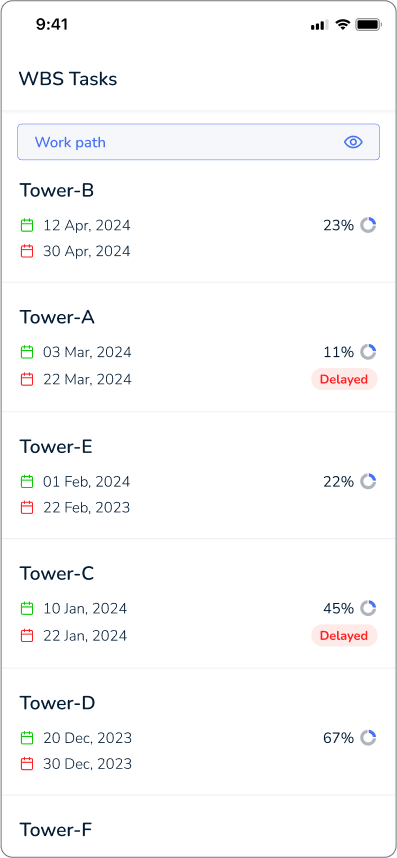
Navigating the construction industry can feel like learning a new language. From materials and tools to project management and job titles, there’s a vast array of terms to understand. Whether you’re a seasoned professional or new to the field, having a solid grasp of construction terminology is essential for effective communication and successful project execution. Here’s a comprehensive glossary of construction terms and definitions to help you speak the language of construction fluently:
Construction Materials and Tools:
- Aggregate: Aggregate is a mixture of construction materials like sand, gravel, and other small bits that is mixed with glue-like stuff to make strong building materials.
- Beam: A beam is a long, sturdy piece of material, like wood or metal that goes across a building to hold up the roof or floor.
- Caulk: Caulk is a sticky substance used to fill in gaps and seal joints around windows, doors, and other openings in buildings to prevent air or water from getting in.
- Circuit Breaker: Essential for electrical safety, a circuit breaker serves to regulate and interrupt excess electrical current flow, protecting circuits from overload or short circuits.
- Concrete: Formulated from water, sand, gravel, and additives, concrete serves as a versatile building material, poured into molds to create sturdy structures like slabs, driveways, and columns.
- Drywall: Also known as plasterboard or gypsum board, drywall panels provide a versatile solution for constructing walls and ceilings, offering ease of installation and customization.
- Ducts: A duct typically refers to a passageway for air circulation, commonly found in heating, ventilation, and air conditioning (HVAC) systems within buildings.
- Insulation: Foam, cellulose, fiberglass, and foil stuff that fills walls to stop sound or heat from moving from one part of a building to another.
- Mortar: Comprising materials like clay or asphalt, mortar binds together bricks and stones in a wall.
- Pallet: An economical solution for material handling, pallets offer a sturdy wooden platform for moving and storing construction materials, facilitating logistics on job sites.
- Particle Board: Plywood like board made out of resin.
- Rafter: A rafter refers to a structural component of a roof that supports the roof covering and transfers weight to the walls.
- Veneer: A thin layer of wood applied over other materials, to enhance the appearance of surfaces, & achieve the look of solid wood in construction and furniture design.
Construction Process Terms:
- Area: The measurement of a space in square units.
- Blueprint: Detailed visual representations of construction plans, and blueprints provide essential guidance for builders, architects, and engineers, depicting key project details and specifications.
- Building Information Modeling (BIM): BIM is a 3D digital representation of a building’s physical and functional characteristics, facilitating better planning, design, construction, and management throughout its lifecycle.
- CRM (Customer Relationship Management): CRM refers to the strategies and technologies used to manage interactions with current and potential clients, aiming to foster long-term relationships and maximize sales opportunities.
- CAD (Computer-Aided Design): CAD software empowers designers and architects to create precise and detailed drawings of building plans, streamlining the design process and enabling seamless collaboration.
- Excavation: Excavation involves the removal of soil, rocks, and debris to create foundations & prepare ground for construction.
- ERP (Enterprise Resource Planning): An integrated software solution that streamlines and optimizes various processes such as property management, accounting, and project planning within real estate companies.
- Floor Plan: A scaled representation of a building’s layout, floor plans depict room arrangements and spatial relationships, guiding architectural design and interior layout decisions.
- Footprint: The outline of a building’s foundation, the footprint defines the area occupied by the structure, influencing site layout and development considerations.
- Renovation: The process of improving or restoring existing buildings, renovation projects aim to enhance functionality, aesthetics, and energy efficiency while preserving historical or architectural integrity.
- Warping: The distortion or bending of materials, often due to moisture or temperature changes.
- HVAC: Heating, Ventilation, and Air Conditioning systems that control temperature and air quality in buildings.
- Load-bearing wall: A wall that supports the weight of the structure above it.
- Nonbearing wall: A wall that doesn’t support the structure above it and can be removed without compromising the building’s stability.
- Plat: A Plat is a map or plan showing the boundaries and divisions of land parcels within a development or subdivision.
Construction Business Terms:
- Accessibility: Ensuring buildings and facilities can be used by people with disabilities easily.
- Addendum: A document that adds extra information or changes to a contract or agreement. Usually, a property owner issues an addendum to a contractor to include new information in the construction contract.
- Bid: An offer to do a job or provide goods or services at a certain price.
- Bid solicitation: The process of inviting bids from contractors or suppliers for a project.
- Change order: A document that alters the original scope of work or contract terms during construction.
- Construction Management Software:Technology used to streamline and organize project planning, scheduling, and communication in construction projects.
- Gantt chart: A visual representation of a project schedule, showing tasks, timelines, and dependencies.
- Public-private partnership (PPP): Collaboration between government and private sector entities to finance, develop, and manage projects.
- Request for information: A formal request for clarification or additional details about a project from potential bidders or vendors.
- Request for proposal: A document inviting proposals from contractors or vendors to provide goods or services for a project.
- Request for quote: A request for pricing information from suppliers or contractors for specific goods or services.
- Specifications: Detailed descriptions of materials, dimensions, quality standards, and other requirements for construction projects.
- Zoning: Government regulations that control the use of land and buildings in specific areas, determining what can be built and where.
Construction Jobs:
- Architect: Designs buildings and oversees their construction to ensure they meet aesthetic and functional requirements.
- Building engineer: Manages the technical aspects of construction projects, including structural integrity and systems installation.
- Construction assistant: Supports construction activities by assisting with various tasks, such as site preparation and material handling.
- Construction foreperson: Supervises construction crews, coordinates workflow, and ensures projects are completed safely and on schedule.
- Equipment operator: Operates machinery and equipment used in construction, such as trucks and cranes.
- General contractor: Oversees the entire construction project, coordinating subcontractors and ensuring quality and compliance with plans.
- Inspector: An inspector in the construction industry examines structures and building components to ensure they meet safety standards, regulations, and project specifications.
- Project manager: Leads construction projects from inception to completion, handling planning, budgeting, scheduling, and coordination.
- Scheduler: Manages project timelines, coordinates tasks, and ensures resources are allocated efficiently to meet deadlines.
- Senior construction manager: Provides strategic direction and oversight for multiple construction projects, ensuring they align with organizational goals and standards.







